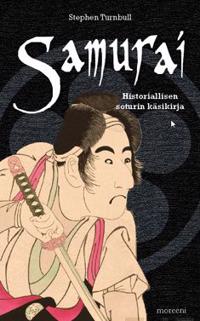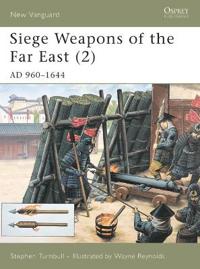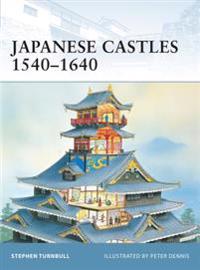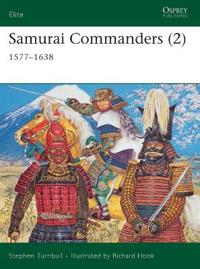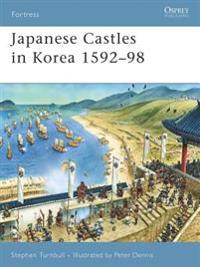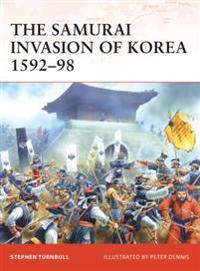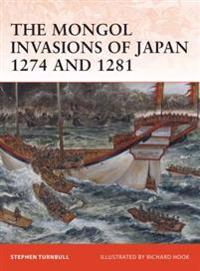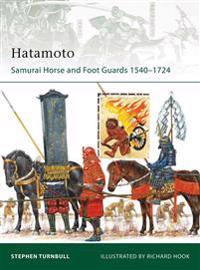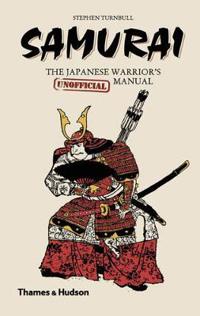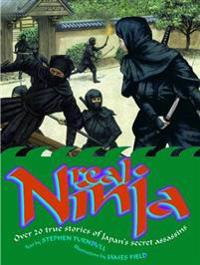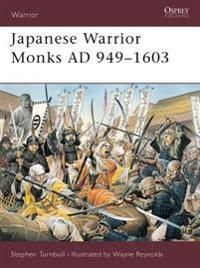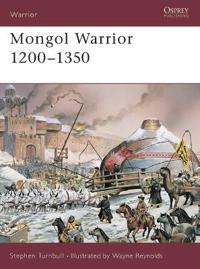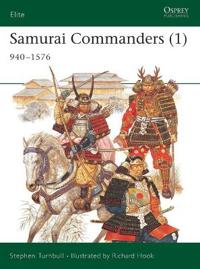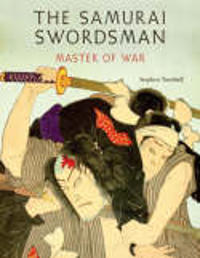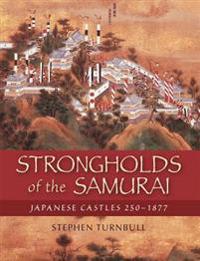Samurai Women 1184-1877 (Pocket)
avTurnbull, Stephen
ISBN: 9781846039515 - UTGIVEN: 2010-10-04Ever since the Empress Jingo-kogo led an invasion of Korea while pregnant with the future Emperor Ojin, tales of female Japanese warriors have emerged from Japan's rich history. Using material that has never been translated into English before, this book presents the story of Japan's female warriors[...]
Samurai - Historiallisen soturin käsikirja (Inbunden)
avTurnbull Stephen
ISBN: 9789522541369 - UTGIVEN: 201301Vuonna 1615 japanilainen eliittisotilasluokka oli valtansa huipulla. Samurai-sotureiden tehtävänä oli totella kuuliaisesti isäntäänsä, puolustaa uskollisesti keisaria ja taistella valtarakenteita uhkaavia barbaareita vastaan. He hallitsivat täydellisesti taistelutekniikat miekkailusta karate[...]
Ashigaru 1467-1649 (Pocket)
avStephen Turnbull, Howard (ILT) Gerrard, Stephen Turnbull
ISBN: 9781841761497 - UTGIVEN: 2001-04The ashigaru were the foot soldiers of old Japan. Although recruited first to swell an army's numbers and paid only by loot, the samurai began to realise their worth, particularly with arquebuses and spears, until well-trained ashigaru made up a vital part of any samurai army. This book tells the st[...]
Siege Weapons of the Far East (Pocket)
avStephen Turnbull, Wayne (ILT) Reynolds, Stephen Turnbull
ISBN: 9781841763408 - UTGIVEN: 2002-01Increasingly from the 11th century AD, East Asian armies used exploding missiles and siege cannon to reduce the fortifications of their enemies. These ranged from heavy siege cannon such as those used during the sige of P'yongyang during the Japanese invasion of the late 16th century, a weapon that [...]
Japanese Castles 1540-1640 (Pocket)
avStephen Turnbull, Peter (ILT) Dennis, Stephen Turnbull
ISBN: 9781841764290 - UTGIVEN: 2003-04The most familiar characteristics of the traditional Japanese castle are the huge sloping stone walls and the graceful yet militarily sophisticated structures built on top of them. This title covers the entire period of Japanese castle development from the first introduction of stone walls and tower[...]
Samurai Commanders (2) (Pocket)
avStephen Turnbull, Richard (ILT) Hook, Stephen Turnbull
ISBN: 9781841767444 - UTGIVEN: 2005-08This second volume about Japan's samurai commanders covers the generals of the later years of the Age of the Warring States, a period when only the most able leaders survived. This was a time when the prowess of a commander was measured as much by his strategic and organizational abilities as by hi[...]
The Walls Of Constantinople Ad 324-1453 (Pocket)
avStephen R. Turnbull, Peter (ILT) Dennis, Stephen R. Turnbull
ISBN: 9781841767598 - UTGIVEN: 2004-11The walls of Constantinople are the greatest surviving example of European medieval military architecture in the world. They withstood numerous sieges until being finally overcome by the artillery of Mehmed the Conqueror in 1453, and exist today as a time capsule of Byzantine and Medieval history. T[...]
Japanese Fortified Temples And Monasteries AD 710?1062 (Pocket)
avStephen R. Turnbull, Peter (ILT) Dennis, Stephen R. Turnbull
ISBN: 9781841768267 - UTGIVEN: 2005-08From the 10th century onwards the great monastic foundations of Nara and Mount Hiei maintained large armies of warlike monks, a practice that was later followed by other institutions. The tempestuous political rivalries that developed between the different orders of monks, and even factions within t[...]
The Great Wall of China 221 BC-AD 1644 (Pocket)
avStephen Turnbull, Steve Noon, Stephen Turnbull
ISBN: 9781846030048 - UTGIVEN: 200701The most extensive and famous example of fortification in the world, the Great Wall of China stretches for more than 4,000 miles across inhospitable terrain. Charting its development from construction in the 7th century BC through to the present day, this account reveals the true history of the wall[...]
Japanese Castles in Korea 1592-98 (Pocket)
avStephen Turnbull, Peter (ILT) Dennis, Stephen Turnbull
ISBN: 9781846031045 - UTGIVEN: 2007-11The Japanese invasion and occupation of Korea, which lasted from 1592 to 1598, was the only occasion in Japanese history when samurai aggression was turned against a foreign country. During the occupation of Korea the Japanese built 25 wajo or castles. Unlike the castles built in Japan, these fortif[...]
The Samurai Invasion of Korea 1592-98 (Pocket)
avStephen Turnbull, Peter (ILT) Dennis, Stephen Turnbull
ISBN: 9781846032547 - UTGIVEN: 2008-07The invasions of Korea launched by the dictator Toyotomi Hideyoshi (1592-1593 and 1597-1598) are unique in Japanese history for being the only time that the samurai assaulted a foreign country. Hideyoshi planned to invade and conquer China, ruled at the time by the Ming dynasty, and when the Korean [...]
The Mongol Invasions of Japan 1274 and 1281 (Pocket)
avStephen R. Turnbull, Richard (ILT) Hook, Stephen R. Turnbull
ISBN: 9781846034565 - UTGIVEN: 2010-01From his seat in Xanadu, the great Mongol Emperor of China, Kubla Khan, had long plotted an invasion of Japan. However, it was only with the acquisition of Korea, that the Khan gained the maritime resources necessary for such a major amphibious operation. Written by eastern warfare expert Stephen Tu[...]
Hatamoto (Pocket)
avStephen Turnbull, Richard (ILT) Hook, Stephen Turnbull
ISBN: 9781846034787 - UTGIVEN: 2010-03Each great samurai warlord, or daimyo, had a division of troops known as the Hatamoto, 'those who stand under the flag'. The Hatamoto included the personal bodyguards, the senior generals, the standard bearers and colour-guard, the couriers, and the other samurai under the warlord's personal command[...]
Samurai (Inbunden)
avStephen Turnbull
ISBN: 9780500251881 - UTGIVEN: 201202Young samurai, do you wish to obtain the martial skills to master the Way of the Warrior? The strategic know-how to lay siege to a castle? The Zenlike composure to conduct a tea ceremony? This witty, informative and unique guide to the samurai class of early modern Japan is presented in the guise of[...]
War in Japan 1467-1615 (e-bok)
avStephen Turnbull
ISBN: 9781472810120In 1467 the Onin War ushered in a period of unrivalled conflict and rivalry in Japan that came to be called the Age of Warring States or Sengoku Jidai. In this book Stephen Turnbull offers a masterly exposition of the Sengoku Jidai, detailing the factors that led to Japan's disintegration into warri[...]
Real Ninja (Inbunden)
avStephen Turnbull, James Field, Coral Tulloch
ISBN: 9781592700813 - UTGIVEN: 200809War in Japan 1467-1615 (Häftad)
avStephen Turnbull
ISBN: 9781841764801 - UTGIVEN: 200208In 1467 the Onin War ushered in a period of unrivalled conflict and rivalry in Japan that came to be called the Age of Warring States. In this text Turnbull offers an exposition of the wars. He explains what led to Japan's disintegration into warring states after more than a century of peace; the ye[...]
Tannenberg 1410 (Häftad)
avStephen Turnbull
ISBN: 9781841765617 - UTGIVEN: 200305By 1400 the long running conflict between the Teutonic Knights and the Polish-Lithuanian kingdom was coming to a head. In June 1410 Ladislos II of Lithuania invaded the Order's territory with an army of 10,000. It included many of the Teutonic Knights enemies - Poles, Lithuanians, Russians, Tartars [...]
Japanese Warrior Monks AD 949-1603 (Häftad)
avStephen Turnbull
ISBN: 9781841765730 - UTGIVEN: 2003-05From the 10th to the mid-17th century, religious organisations played an important part in the social, political and military life in Japan. Known as sohei ('monk warriors') or yamabushi ('mountain warriors'), the warrior monks were anything but peaceful and meditative, and were a formidable enemy, [...]
Mongol Warrior 1200-1350 (Häftad)
avStephen Turnbull
ISBN: 9781841765839 - UTGIVEN: 200311The Mongol warriors were one of the great success stories of world military history. Under the leadership of Genghis Khan and his successors the Mongols conquered much of the known world, fighting in territory ranging from the frozen steppes, the wilderness of Palestine, the jungles of Java and the [...]
The Hussite Wars, 1420 - 34 (Häftad)
avStephen Turnbull
ISBN: 9781841766652 - UTGIVEN: 200405In 1415, the judicial murder of the religious reformer Jan Hus sparked a major uprising in Bohemia. His death led within a few years to the 'Hussite' revolution against the monarchy, the German aristocracy and the Church establishment. For two decades the largely peasant Hussite armies successfully [...]
Samurai Commanders (Häftad)
avStephen Turnbull
ISBN: 9781841767437 - UTGIVEN: 200504Osprey's examination of Samurai commanders during the Gempei Wars (1180-1185), the Onin War (1467-1477), and the early Sengoku period. The samurai were the military elite of medieval and early modern Japan, and the men who led them were hailed as the very greatest, most heroic and most honourable of[...]
Samurai Swordsman (Inbunden)
avStephen Turnbull
ISBN: 9781844157129 - UTGIVEN: 200802Early Japan was a land filled with internal strife and warfare. This title tells the story of the courageous and disciplined fighting men of this time, showing how they evolved from the primitive fighters of the seventh century into an invincible military caste with a fearsome reputation. It examine[...]
Chinese Walled Cities 221 BC - AD 1644 (Häftad)
avStephen Turnbull
ISBN: 9781846033810 - UTGIVEN: 200905It has been said in China that a city without a wall would be as inconceivable as a house without a roof. Even the smallest village invariably had some form of defensive wall, while the Great Wall of China was an attempt to build a barrier along the most vulnerable border of the entire country. Yet [...]
Strongholds of the Samurai (Inbunden)
avStephen Turnbull
ISBN: 9781846034138 - UTGIVEN: 200903The earliest fortifications in Japan were developed with the appearance of the first emperors in around 250 and were often simple wooden constructions. As internal strife became a way of life in Japan, more and increasingly elaborate fortifications. This book covers the entire period of Japanese cas[...]


